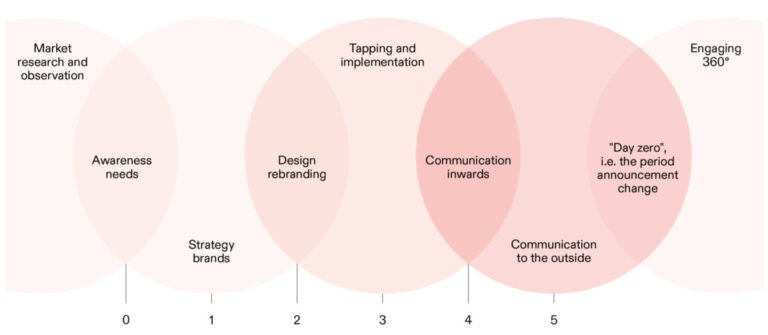Rebranding is the process of changing the visual and conceptual identity of a brand.
It can be caused by various reasons: obsolescence of the image, inconsistency with modern market requirements, the desire to attract a new audience or strengthen one’s position in the market. In any case, rebranding is a complex and multi-step process that requires careful planning and analysis.
Very often it is associated with changes in the organization of the business itself. For example, a company may reconsider its development strategy or expand its product range. To successfully carry out a rebranding, it is necessary to take into account all these factors and create a new brand concept that will reflect its new position in the market and contribute to achieving its goals. It is equally important to ensure a smooth transition from the old brand to the new one in order to minimize customer losses and maintain the loyalty of the existing audience.
Concept, purpose and basic principles

The purpose of rebranding can be different: from increasing brand awareness to updating its concept and values. The main task is to create a new image of the company that will meet its strategic goals and market requirements.
Basic principles include:
- Analysis of the current state of the brand. Before starting the process, it is necessary to conduct an in-depth analysis of the available data about the brand, its status in the market, audience preferences and competitive environment.
- Development of strategy and concept. Based on the data obtained, the rebranding strategy and concept are determined, which will form the basis of all subsequent steps.
- Changing the visual and verbal identity of the brand
Experience of successful companies: how rebranding influenced business development
The experience of successful companies shows that rebranding can have a significant impact on the business. First, it can help a company attract new customers and increase interest in its product or service. Revisiting the logo, packaging design or updating the website can make the brand more modern and attractive to the target audience.
Secondly, rebranding can help a company reinvent itself and adapt to changing market demands. For example, if a company notices a decrease in demand for its main products, it can carry out this procedure and expand its range or move to the production of other products. This strategy allows you to maintain competitiveness and avoid losing customers.
Finally, a successful rebrand can create new career opportunities for company employees. A company that does this often becomes a more attractive employer and can attract talented people. Additionally, a rebrand may involve a change in company strategy, which may open up new positions or career opportunities.
Analysis, strategy, implementation
Rebranding is a big step for any business, but if done correctly, it can be a key factor in success. To successfully complete the rebranding process, you need to follow certain steps.

The first and most important step is to analyze the current situation. It is necessary to conduct in-depth research of your business, study the market and competitors, and identify the company’s strengths and weaknesses. This will help you understand what changes need to be made and what the new rebranding strategy should be.
The next step is to develop a rebranding strategy. At this stage, it is necessary to define a new purpose and values of the company, create a unique offer for customers and develop a new brand image. It is important to take into account the opinions of company employees, as they will be the key implementers of changes.
Introducing a new brand is the last but not least important step towards a successful rebranding. It is necessary to develop an action plan to launch a new brand on the market, conduct training for employees and customers, and actively promote the new image of the company through various communication channels.
A means of attracting new clients and strengthening your image
Rebranding is not only a change in the external appearance of a company, but also a powerful tool for attracting new customers and strengthening its image. Transitioning to a new brand can generate interest among a wide audience that previously did not pay attention to the company or considered it outdated.
A new logo, slogan, packaging or website design – all this helps to attract the attention of potential customers and make them want to get acquainted with the company’s offer. Rebranding also allows you to convey a new message about the company’s goals and values, which can appeal to new audiences.

In addition, it helps strengthen the company’s image. The brand update emphasizes the willingness to change and follow the demands of the times. This creates a positive impression of the company among potential clients and makes it more competitive in the market.
Conclusions and recommendations
Rebranding is a powerful tool that can help your work or business reach new heights. In this subsection, we will consider the main conclusions and recommendations on why you should think about carrying out this procedure.
Firstly, rebranding allows you to update your image and attract attention to yourself. In today’s rapidly changing world, it is important not only to be a good professional or offer a quality product, but also to be able to stand out from the competition. Rebranding will help create a new image of work or business that will attract the attention of clients and partners.
Secondly, this process makes it possible to adapt to a changing environment. If you notice that your work or business is no longer as relevant as it once was, then rebranding may be a way to adapt to new demands and customer needs.













